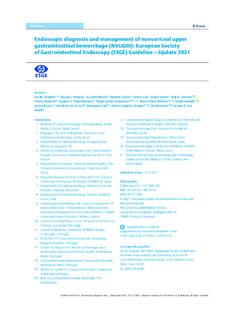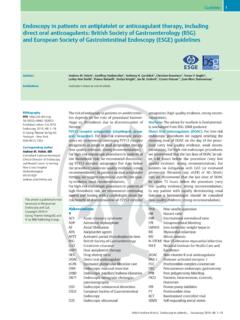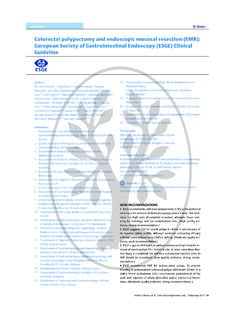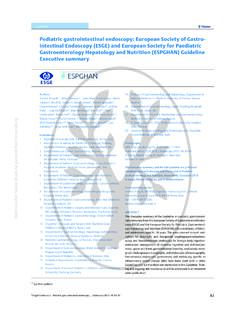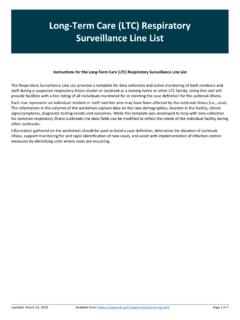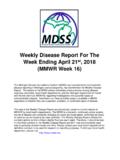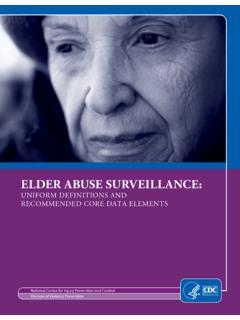Transcription of Post-polypectomy colonoscopy surveillance: European ...
1 Post-polypectomy colonoscopy surveillance : European Societyof Gastrointestinal Endoscopy (ESGE) Guideline Update 2020 AuthorsCesare Hassan1, Giulio Antonelli1, Jean-Marc Dumonceau2, Jaroslaw Regula3, Michael Bretthauer4,StanislasChaussade5, Evelien Dekker6, Monika Ferlitsch7, Antonio Gimeno-Garcia8,RodrigoJover9,MetteKalage r4,MariaPellis 10,ChristianPox11, Luigi Ricciardiello12, Matthew Rutter13, Lise M rkved Helsingen4, Arne Bleijenberg6,CarloSenore14, Jeanin E. van Hooft6, Mario Dinis-Ribeiro15, Enrique Quintero8 Institutions1 Gastroenterology Unit, Nuovo Regina MargheritaHospital, Rome, Italy2 Gastroenterology Service, H pital Civil Marie Curie,Charleroi, Belgium3 Centre of Postgraduate Medical Education and MariaSklodowska-Curie Memorial Cancer Centre, Institute ofOncology, Warsaw, Poland4 Clinical Effectiveness Research Group, Oslo UniversityHospital and University of Oslo, Norway5 Gastroenterology and Endoscopy Unit, Facult deM decine, H pital Cochin, Assistance Publique-H pitaux de Paris (AP-HP)
2 , Universit Paris Descartes,France6 Department of Gastroenterology and Hepatology,Amsterdam University Medical Centers, University ofAmsterdam, The Netherlands7 Department of Internal Medicine III, Division ofGastroenterology and Hepatology, Medical UniversityVienna, and Quality Assurance Working Group,Austrian Society for Gastroenterology and Hepatology,Vienna, Austria8 Gastroenterology Department, Hospital Universitariode Canarias, Instituto Universitario de Tecnolog asBiom dicas (ITB) & Centro de Investigaci n Biom dicade Canarias (CIBICAN), Universidad de La Laguna,Tenerife, Spain9 Service of Digestive Medicine, Alicante Institute forHealth and Biomedical Research (ISABIAL Foundation),Alicante, Spain10 Gastroenterology Department, Endoscopy Unit,ICMDiM, Hospital Clinic, CIBEREHD, IDIBAPS,University of Barcelona, Catalonia, Spain11 Department of Medicine, St. Joseph Stift, Bremen,Germany12 Department of Medical and Surgical Sciences,S.
3 Orsola-Malpighi Hospital, Bologna, Italy13 Gastroenterology, University Hospital of North Tees,Stockton-on-Tees, UK and Northern Institute forCancer Research, Newcastle University, Newcastleupon Tyne, UK14 Epidemiology and screening Unit CPO, Citt dellaSalute e della Scienza University Hospital, Turin, Italy15 CIDES/CINTESIS, Facultyof Medicine, University ofPorto, Porto, PortugalGuidelineBibliographyDOI online: | Endoscopy 2020; 52: 1 14 Georg Thieme Verlag KG Stuttgart New YorkISSN 0013-726 XCorresponding authorC. Hassan, MD, Nuovo Regina Margherita Hospital, ViaE. Morosini 53, 00159, Rome, ItalyFax: 1s 3sOnline content viewable at: RECOMMENDATIONSThe following recommendations for Post-polypectomy colonoscopic surveillance apply to all patients who had one or more polyps that were completely removed during a high quality baseline ESGE recommends that patients with complete removal of 1 4 < 10 mm adenomas with low grade dysplasia, irrespec-tive of villous components, or any serrated polyp < 10mm without dysplasia, do not require endoscopic surveillance and should be returned to recommendation, moderate quality organized screening is not available, repetition of colonos-copy 10 years after the index procedure is recommended.
4 Strong recommendation, moderate quality Cesare et al. Post-polypectomy colonoscopy surveillance : ESGE Guideline Update 2020 .. Endoscopy 2020; 52 IntroductionThis Guideline represents an update of the Guideline on Post-polypectomy endoscopic surveillance published by the Europe-an Society of Gastrointestinal Endoscopy (ESGE) in 2013 [1].Previous recommendations were primarily based on esti-mates of the risk of metachronous advanced neoplasia (ad-vanced adenoma or colorectal cancer [CRC]) according to theendoscopic and histological features at the baseline colonosco-py that represented most of the available to the Grading of Recommendations Assessment,Development and Evaluation (GRADE) methodology adoptedfor ESGE guidelines [2,3], a hierarchy across outcomes must becreated, and the main recommendations should be based onSOURCE AND SCOPEThis Guideline is an official statement of the EuropeanSociety of Gastrointestinal Endoscopy (ESGE). It is an up-date of the previously published 2013 Guideline address-ing the role of Post-polypectomy colonoscopy detection rateARRadjusted rate ratioCIconfidence intervalCRCcolorectal cancerEMRendoscopic mucosal resectionESGEE uropean Society of Gastrointestinal EndoscopyFITfecal immunochemical testFOBT fecal occult blood testGRADEG rading of Recommendations Assessment,Development and EvaluationHbhemoglobinHGDhigh grade dysplasiaHRhazard ratioLSTlaterally spreading tumorORodds ratioPICO population, intervention, comparison/control,outcomeRCTrandomized controlled trialRRrisk ratioSDstandard deviationSERTS ydney EMR Recurrence ToolSIRstandardized incidence ratioSSLsessile serrated lesion2 ESGE recommends surveillance colonoscopy after 3 yearsfor patients with complete removal of at least 1 adenoma 10mm or with high grade dysplasia, or 5adenomas,orany serrated polyp 10mm or with recommendation.
5 Moderate quality recommends a 3 6-month early repeat colonos-copy following piecemeal endoscopic resection of polyps recommendation, moderate quality first surveillance colonoscopy 12 months after the repeatcolonoscopy is recommended to detect late recommendation, high quality no polyps requiring surveillance are detected at the firstsurveillance colonoscopy , ESGE suggests to perform a sec-ond surveillance colonoscopy after 5 recommendation, low quality that, if no polyps requiring surveillance are detected,patients can be returned to suggests that, if polyps requiring surveillance aredetected at first or subsequent surveillance examinations, surveillance colonoscopy may be performed at 3 recommendation, low quality flowchart showing the recommended surveillance inter-vals is provided ( ).High quality colonoscopyPolyp requiring surveillance ?Return to screeningYesYesYesNoNo3-year surveillancePolyp requiringsurveillance?Polyp requiringsurveillance?
6 5-year surveillanceNo surveillance intervals following Cesare et al. Post-polypectomy colonoscopy surveillance : ESGE Guideline Update 2020 .. Endoscopy 2020; 52 Guidelinethe estimates of benefit and risk(burden) of the most clinicallyrelevant outcomes. In this regard, risk of CRC incidence andmortality was ranked as a more relevant outcome than the riskof metachronous advanced neoplasia for estimating the benefitof Post-polypectomy surveillance . Of note, this applies both tothe stratification of baseline risk at index colonoscopy and to theassessment of the efficacy of endoscopic , a series of cohort studies assessed the Post-polypectomy risk of CRC incidence/mortality with and withoutendoscopic surveillance . The overall long-term CRC risk follow-ing polypectomy appeared to be similar or slightly higher thanfor the general population or for patients without adenomas. Indetail, a 2% absolute long-term CRC risk for post-polypectomypatients without surveillance has been shown, ranging be-tween and according to the baseline risk stratifica-tion [4].
7 These estimates were confirmed in a surveillance set-ting, with a 10-year CRC incidence risk between , and mortality risk between and [5]. In ad-dition, the efficacy of surveillance for patients at high risk ofCRC appeared to be less than 1% [4], while it was ineffective inpatients at lower risk (Table1s;seeAppendix 1s, online-onlySupplementary Material). Of note, these estimates are muchlower than the 3% long-term CRC risk required in one guidelineforrecommendingCRCscreening[6]. Overall, thisnewevidencesupports a very conservative and selective approach to Post-polypectomy compared with the 2013 ESGE Guideline, the roles ofsome endoscopic or histological risk factors have been ques-tioned. In particular, the risks of multiplicity or of villous histol-ogy regarding CRC in the long-term seem to be low or negligi-ble, hence the relevance of these factors in stratification of thebaseline risk is now questioned [4,7,8]. Furthermore, addition-al evidence based on long-term risk of CRC incidence and mor-tality has become available with regard to serrated polyps,strengthening the previous recommendations [9 11].
8 The efficacy of endoscopic surveillance must be weighedagainst safety and burden. Diagnostic colonoscopy is consid-ered to entail a very low risk of adverse events with estimatesof , , and for perforation, bleeding, anddeath, respectively [12]. However, these risks may increase inpatients with co-morbidities or older age [13] (Table2s). In ad-dition, unfavorable psychological effects of surveillance havealso been shown, at least in patients with high risk adenomas[14]. colonoscopy capacity is limited and is mainly expendedin population-based organizedCRC screening programs, aseither work-up of a positive fecal-based stool test or primaryscreening intervention. The very high prevalence of adenomasin the era of quality assurance and high definition colonoscopy up to over 70% of the screening population [15] mandatesa conservative surveillance policy in order to avoid waste of re-sources [14,16 18] (Table3s).The primary aim of this ESGE update is to incorporate newevidence into the clinical recommendations to be adopted inroutine and specific commissioned the update of this Guideline and appointeda guideline leader ( ), who invited the listed authors to par-ticipate in the project development.
9 The key questions wereprepared by the coordinating team ( , , ) usingPICO methodology (population,intervention, comparison/con-trol, outcome) [19] and were then approved by the other mem-bers. The coordinating team formed task force subgroups,based on the statements of the 2013 guideline, each with itsown leader, and divided the key topics among these task forces(Appendix 2s) with a specific focus on the update of literatureand revision of the ESGE Guidelines have addressed endoscopic surveil-lance after endoscopic or surgical resection of invasive carcino-ma/malignant polyp [20] and of patients with hereditary syn-dromes or with polyposis syndromes [21,22], and these topicsare not addressed in the present work included telephone conferences, a face to facemeeting and online task forces conducted a literature search using Medline(via Pubmed) and the Cochrane Central Register of ControlledTrials up to October 2019. New evidence on each key questionwassummarizedintablesusingtheGRA DE system[3](Appen-dix 3s).
10 Grading depends on the balance between the benefitsand risk or burden of any health intervention [23].Furtherdetails on guideline development have been reported else-where [2].Theresultsofthesearchwerepresentedto allthemembersof the task forces during a meeting in Barcelona on October19th, this meeting drafts were made by the leadersof each task force and distributed between the task force mem-bers for revision and online discussion. Statements were cre-ated by December 2019, a draft prepared by , and theleaders of all the task forces was sent to all group agreement of all members, the manuscript was reviewedby two external reviewers and was sent for further commentsto the ESGE national societiesand individual members. Afterthis, the manuscript was submitted to the journalEndoscopyfor publication. The final revised manuscript was agreed uponby all the Guideline was issued in 2020 and will be considered forupdate in 2025. Any interim updates will be noted on the ESGE website: and StatementsFor this update, we decided to use the term polyp instead of lesion or neoplasia as the latter two terms can have overlynegative connotations for both medical and nonmedical audi-ences.



